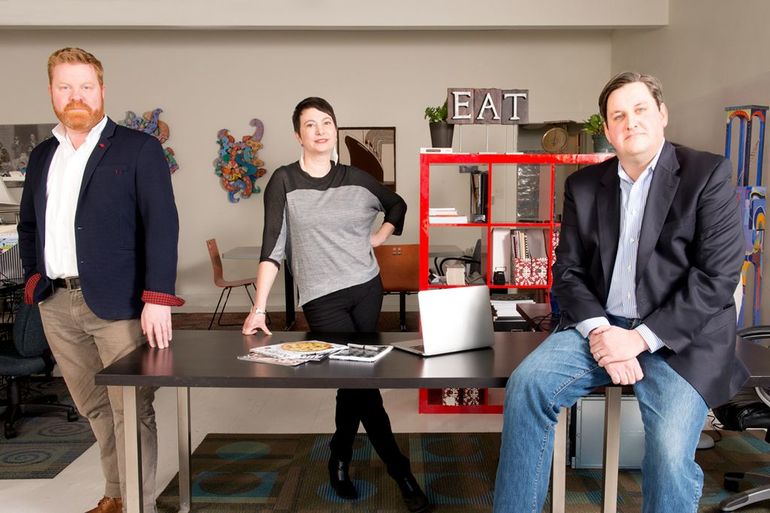Maine Restaurant Week founders, digital media pro tap growing email newsletter market
 Photo / Ted Axelrod / Axelrod Photography
Eat Drink Lucky owners Jim Britt, Gillian Britt and Kevin Phelan in their South Portland office.
Photo / Ted Axelrod / Axelrod Photography
Eat Drink Lucky owners Jim Britt, Gillian Britt and Kevin Phelan in their South Portland office.
When it comes to food and drink recommendations, the digital revolution has brought us apps, blogs and social media to help us with decisions. But with so little time to browse, tap and scroll, how are we supposed to process all this information?
Enter “Eat Drink Lucky,” a new venture by the founders of Maine Restaurant Week and a digital media professional that hopes to solve that problem by simplifying how food and drink lovers learn about the latest and greatest places. And it’s being done through an old format the founders say is experiencing a re-emergence among media companies: the email newsletter.
Gillian and Jim Britt, of South Portland public relations firm gBritt PR, and Kevin Phelan, who previously worked for Gutenberg Communications in Boston, launched EDL as a daily email newsletter last September in 10 markets, including Portland, Boston, Chicago, Los Angeles and Washington, D.C. That means the company is sending 70 emails a week, roughly 300 emails a month and eventually 3,650 emails a year.
Now, after hitting the “send” button for over 90 days, Phelan, Jim and Gillian told Mainebiz that EDL is ready for “aggressive growth” this year. Though they didn’t share current subscriber information, they said based on current trajectories, they are set to reach 30,000 subscribers between the 10 markets by September, marking the email newsletter’s one-year anniversary.
“[It’s a lot of content], which is why we took the first 90 days to really hone that process,” Phelan said in explaining why the company has been quiet about its efforts until now.
Phelan said EDL has been funded by friends and family so far, but the company is now entering its Series A round of funding, which will be used to expand the startup’s editorial team, boost subscriber traction and develop distribution partnerships. He declined to say how much the company has raised for start-up costs or how much it is seeking from investors, but the company, working from gBritt’s Ocean Street office in South Portland, seems confident.
“We wouldn’t be doing it if the opportunity wasn’t right,” Jim said. “We’re not going to allow ourselves to get distracted when [our families’ lives] are on the line. We’re risking a lot.”
'Snackable content'
The premise behind EDL is simple: Every day at 7 a.m. EDL sends subscribers in each market an email that suggests one restaurant (Eat), one drink or one place to drink (Drink) and one place or activity that offers a quality of life experience (Lucky). The emails are surprisingly short, with Monday’s Portland newsletter suggesting Little Tap House, Valderhermosa wine at Vignola Cinque Terre and the Tough Mudder obstacle course in Westbrook in just under 159 words.
The EDL team calls it “snackable content.”
“I jokingly say it takes two sips of coffee to consume an entire EDL and that’s it,” Jim Britt said. “And that’s what we want. We want it to be a quick, informative, really fun and exceptionally well-written blast of information that lands in your inbox.”
EDL’s team currently has five full-time staffers, including Phelan, the company’s CEO; Gillian Britt, the executive editor; and Jim Britt, the company’s drink concierge. To help develop the content, Phelan said EDL relies on a network of paid freelancers across its 10 markets, sending in content that is then edited by Gillian’s editorial team.
“We don’t dictate the content,” Gillian said, “but mostly we’re focused on making sure it’s something that’s worthy of attention, so it leaves a lot of flexibility with the writers to say, ‘this is something I’ve seen locally.’”
Phelan said the company also accepts reader tips. But, he added, what also informs the editorial process is the use of social listening tools to analyze tweets, Google searches and other online data to see what restaurants and items might be trending in any given week.
“It’s a traditional media room that’s embracing technology and data science,” Phelan said.
'A data-driven decision'
So how does the EDL team know there’s gold to be found in this market?
The first answer: six months of market research.
“We spent quite a bit of time researching different markets, populations, number of restaurants and what kinds of things are being said about these restaurants,” Gillian said.
During that time, the team also looked at what kinds of inbound and outbound communication models media companies are using to reach their audience. During their interview with Mainebiz, Phelan was able to name some successful email newsletter businesses and how much venture capital they have raised — or how much they have been sold for — with ease.
For instance, Phelan said, TheSkimm daily newsletter, which was founded by two former producers at NBC News, raised $6.25 million in December from a group of investors, including one that has backed Buzzfeed and Irving Azoff, the former CEO of Ticketmaster.
There’s also DailyCandy, Phelan said, a daily newsletter that focused on women’s fashion and other topics and was sold to Comcast for a reported $125 million in 2008. (The newsletter, which once reached 1.2 million readers across eight cities, was killed last year by NBCUniversal, which merged with Comcast a year after the acquisition.)
Last but not least, Phelan said, Tasting Table — considered the “DailyCandy for foodies” — had a reported value of $50 million in 2013.
“It was kind of a data-driven decision that said, ‘OK, we see a market need where years ago Tasty Table was doing this for an older audience, but we think there’s a need’” for a millennial audience, he said, citing a recent BBDO study finding that 48% of millennials — those who were born between the late 1970s and early 1990s — consider themselves “foodies.”
Aside from EDL’s own research, the Columbia Journalism Review wrote in December that email newsletters are “part of a growing trend” seeking “to tell readers ‘everything’ they need to know, and to do it with bite-sized, voicey analysis.” Adweek last April wrote that “email newsletter companies stand to get premium dollars for ads,” partly because “it’s native for mobile” and the average mobile user “spends nine minutes daily with their emails.”
Generating revenue
Aside from running a few pilot advertising campaigns, EDL has yet to enter its revenue-generating phase. The EDL team said that’s been intentional because they’ve wanted to take the time to develop the newsletter’s voice and ensure it’s a high-quality product.
Phelan said the company plans to skip over traditional web banners in favor of native advertising, a form of advertising that is becoming increasingly popular for marketers because of its effectiveness. Native advertising has also generated controversy because of how the ads can closely mimic the editorial content of the publication they appear in. However, the EDL team said they want to make sure there is no confusion and that the ad placements are clearly delineated.
“It’s something that’s personally important for us,” Gillian said.
Phelan said EDL will ideally have a few long-term advertisers instead of ones who may only seek a few daily placements. He said the revenue could also come in the form of sponsorships that would give companies a chance to put their name near the header of the email. He said he’s confident that company can break even once it starts running ads and sponsorships.
Once the company starts attracting outside investment, the EDL team said it plans to work on building content syndication relationships with outside companies, along with developing its own EDL-themed events, that would bring in other sources of revenue.
It may sound like a tall order, but the EDL team seems like they’re up for the challenge.
Phelan said, “What I think is driving a really big piece of my heart in this is, ‘OK, can we build this great media company in Maine? After 90 days [of sending emails] —”
“I think we can,” Jim finished.










Comments